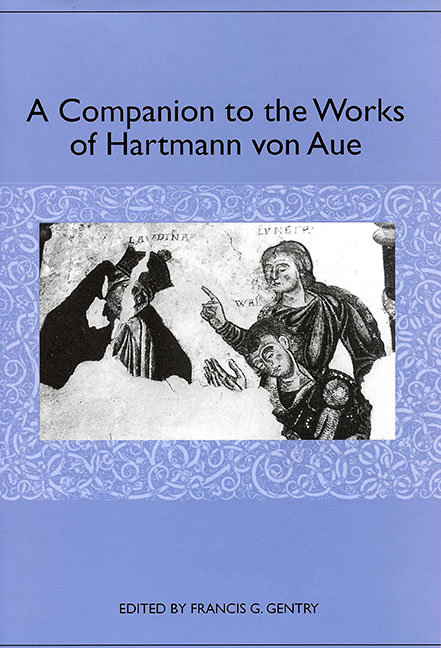Book contents
- Frontmatter
- Contents
- Acknowledgments
- Introduction
- Hartmann's Theological Milieu
- Hartmann von Aue as Lyricist
- Hartmann von Aue and Chrétien de Troyes: Respective Approaches to the Matter of Britain
- Gender and Love in the Epic Romances of Hartmann von Aue
- The Two-Fold Path: Erec and Enite on the Road to Wisdom
- The Body in Pain in the Works of Hartmann von Aue
- Illness and Cure in Hartmann von Aue's Arme Heinrich and Iwein
- Hartmann's Legends and the Bible
- Hartmann's Works in the Visual Arts
- The Medieval Literary Reception of Hartmann's Works
- A Tale of Sacrifice and Love: Literary Way Stations of the Arme Heinrich from the Brothers Grimm to Tankred Dorst
- Editions and Translations of Hartmann's Works
- Works Cited
- Notes on the Contributors
- Index
Hartmann's Works in the Visual Arts
Published online by Cambridge University Press: 27 April 2017
- Frontmatter
- Contents
- Acknowledgments
- Introduction
- Hartmann's Theological Milieu
- Hartmann von Aue as Lyricist
- Hartmann von Aue and Chrétien de Troyes: Respective Approaches to the Matter of Britain
- Gender and Love in the Epic Romances of Hartmann von Aue
- The Two-Fold Path: Erec and Enite on the Road to Wisdom
- The Body in Pain in the Works of Hartmann von Aue
- Illness and Cure in Hartmann von Aue's Arme Heinrich and Iwein
- Hartmann's Legends and the Bible
- Hartmann's Works in the Visual Arts
- The Medieval Literary Reception of Hartmann's Works
- A Tale of Sacrifice and Love: Literary Way Stations of the Arme Heinrich from the Brothers Grimm to Tankred Dorst
- Editions and Translations of Hartmann's Works
- Works Cited
- Notes on the Contributors
- Index
Summary
In contrast to other canonical works of the Middle High German classical period (ca. 1170–ca.1250) such as Tristan, Parzival,and Willehalm,the works of Hartmann von Aue gave rise to no manuscript illumination. His courtly romances, on the other hand — primarily Iwein but also in one notable instance Erec — provoke a great variety of responses in the monumental and decorative arts, beginning early in the thirteenth century and continuing into the fifteenth. Later, near the end of the Middle Ages, short texts on the Gregorius tale — derived from Hartmann's work — begin to be accompanied by illustrations both in manuscripts and in early printed books. In the present survey of Hartmann in the visual arts, it is also appropriate to mention the miniatures depicting Hartmann himself that accompany his lyrics in the Manesse and Weingartner song manuscripts.
The great diversity of the visual responses to Hartmann's works illustrates an essential fact about the broader reception of medieval literary materials in the visual arts: namely, the fundamental independence of the visual arts from the original or canonical texts. Artists dealing with Iwein and Erec obviously felt free to reshape the stories in accordance with their own artistic intentions, including certain plot elements and omitting others, emphasizing here one aspect, there another, drawing on iconographic traditions not only to help visualize stories and characters but also to shape meaning and vary the emotional charge. In the case of some Iwein artworks as well as the Gregorius illustrations, independent structures such as the topos of the Slaves of Love or a collection of saints’ legends essentially take over the narrative material, and the resulting art work derives its meaning as much or more from the new structure as from anything inherent in the story.
When one considers the variety of ways visual artists have responded to Hartmann's Arthurian romances, it almost appears as if they set out to offer the widest possible range of answers to the question posed by the wild man in Iwein: “Âventiure: waz ist daz?” (Adventure: What is that?, 527; Rushing 1995, 23–24).
- Type
- Chapter
- Information
- A Companion to the Works of Hartmann von Aue , pp. 161 - 182Publisher: Boydell & BrewerPrint publication year: 2004



